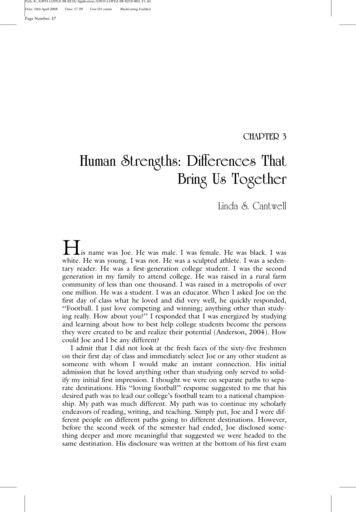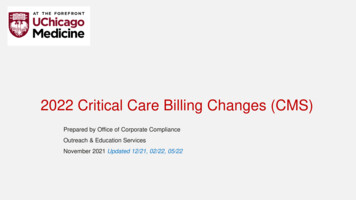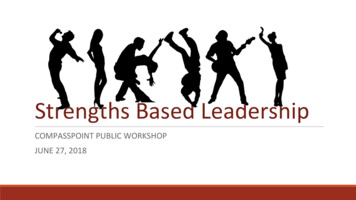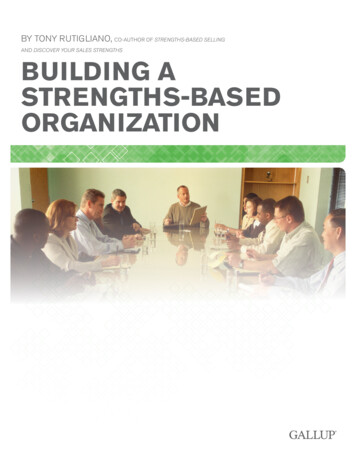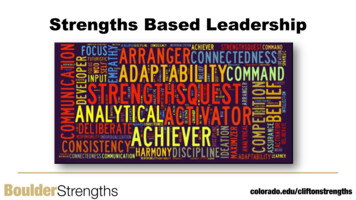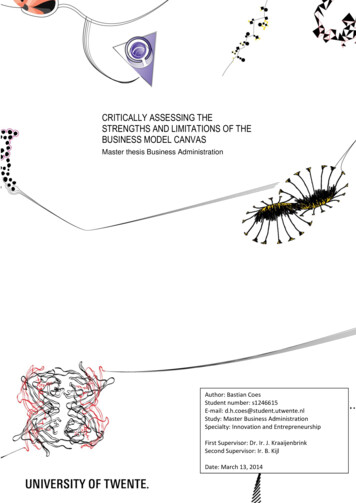
Transcription
CRITICALLY ASSESSING THESTRENGTHS AND LIMITATIONS OF THEBUSINESS MODEL CANVASMaster thesis Business AdministrationAuthor: Bastian CoesStudent number: s1246615E-mail: d.h.coes@student.utwente.nlStudy: Master Business AdministrationSpecialty: Innovation and EntrepreneurshipFirst Supervisor: Dr. Ir. J. KraaijenbrinkSecond Supervisor: Ir. B. KijlDate: March 13, 20141
AcknowledgementsThis thesis is the last part of the graduation from the Master BusinessAdministration at the University of Twente. The subject of this master thesis is inline with my specialization track and personal interest ‘Innovation andEntrepreneurship’. I had a great time and learned a lot at the University ofTwente. Therefore I want to thank all the people who shared knowledge with meduring college hours as well during the group work.Especially, many thanks to Dr. Ir. Jeroen Kraaijenbrink for facilitating thisgraduation topic about Business Model Canvas and for supervising the research.The given feedback was of great use during the process of research and writingthe thesis. Furthermore, many thanks to second supervisor Ir. Björn Kijl forgiving feedback at the last stage of my research.Equally important are my words of thank to the participants in the interviews forscheduling a lot of time of their busy agendas and for validating the writtenresults.Last but not least, I would like to thank my family, girlfriend, friends and fellowstudents for supporting me during the whole master and especially during thethesis phase.Nijverdal, March 2014Bastian (D.H.) Coesd.h.coes@student.utwente.nl2
Executive summaryThe Business Model Canvas is a popular tool for designing business models andhas contributed to the use of more business models in organizations. Based onthis research strengths and limitations are recognized which should be taken intoaccount when working with the Business Model Canvas. The strengths andlimitations are extracted from three sources of information. First a theoreticalanalysis and theoretical comparison with alternative business model tools isexecuted, second an online review is conducted at online blog posts and onlinecomments on discussion threads are analyzed, and third, interviews withexperienced business model developers is done. Based on the triangular resultsthe Business Model Canvas strengths are about the centrality of capturing anddelivering value when designing a business model. Furthermore, strong pointsare the visual representation, usefulness and simplicity of designing andcommunicating business models. The Business Model Canvas is seen byinterviewees as a tool contributing to the communication about business modelswith employees, partners and customers. Next to these strengths, severallimitations are identified. The main limitations based on the three sources of dataare: the exclusion of external forces to a business model, such as competition,market factors and other external forces, and the narrowness of the ValueProposition. In the Business Model Canvas the focus is on creating value withrevenue on return. This excludes other purposes of organizations such as nonprofit and governmental organizations. Furthermore, the difference between thelevel of detail of description in the building blocks is a limitation. The separationof Key Activities and Key Resources imply a higher level of detail about what theorganization need to do to create its Value Proposition, the same counts forChannels and Customer Segments. Which is directed at more detail then forexample the building blocks Key Partners and Customer Segment. Otherlimitations are directed at what the mechanisms between the individual buildingblocks are. Suggested is to create these mechanism by team cooperation andmaking a story next to the Business Model Canvas. Business Model Canvas usersshould be at least aware of these limitations and know how to cope withlimitations. Also business model developers could consider to adjust the BusinessModel Canvas or to use adjusted business model tools.3
Research abstractAim of study The aim of this research is to identify positive and negativecriticism about the Business Model Canvas. The business model literature andresearch field is a relatively new research topic. The concept business model fororganizations is an increasing topic of interest. The results of this research mayadd insights to the discussion about business model tools and particularly on theBusiness Model Canvas on academic level as well as on business practice level.Methodology The research goal is to find strengths and limitations of theBusiness Model Canvas. To answer the question: ‘What are the strengths andlimitations of the Business Model Canvas in the design and application phases ofa business model?’ an exploratory research is needed. A combination with anonline review and a multiple-case study method is used to analyze differentcases and the experience of the interviewee with the Business Model Canvas. Theonline review is used to find a broader view on strengths and limitations frombusiness practioners. An extensive online search of online resources isconducted. Sources of these comments are websites, blogs and forums. Themultiple-case study interviews are conducted with six users of the BusinessModel Canvas in different types of organizations to extract experiences with thetool. During the interview the Business Model Canvas is analyzed on experiencein the interviewees’ organization, where the business model is analyzed onvalidity, reliability and controllability. The case selection is done trough Snowballsampling and the data analysis is based on a narrative approach. Between thesedifferent stories the cases will be compared on agreement and disagreement.Results Based on the different research methods interesting strengths andlimitations of the Business Model Canvas are explored. Between the differentresearch methods a pattern can be recognized between strengths andlimitations. Strength of the centrality of value in making business models, thevisual representation and usability is attributed to the Business Model Canvas.Limitations such as the exclusion of competition and the narrow aim to profitgenerating organizations are identified.Implications This research contributes to the theoretical discussion about anideal type of business model and corresponding business model tools. In practicalterms this research contributes to the awareness of the strengths and limitationsof the Business Model Canvas which may optimize business model designprocesses. Furthermore, this research provides clues of improvement of businessmodel tools and in particular to the Business Model Canvas.Future research To improve the reliability of the research a bigger sampleshould be used to strengthen the prove of the explored strengths and limitations.To gain more validity individual findings should be investigated in higher detail.For example, by conducting an empirical research on a big sample. Futureresearch should be focusing to an ideal type of a business model and therewithan ideal business model tool.4
Table of contentsAcknowledgements . 2Executive summary . 3Research abstract . 41.Introduction . 71.1 Motivation, relevance and research gap . 71.2 Research question . 81.3 Overview. 92.Theory. 102.1 Definition, purpose and elements . 102.2 Relation Business model with other concepts . 132.3 Business model tools and alternative business model tools. 192.4 Conclusion strengths and limitations of the Business Model Canvas based on literature . 293.Methodology . 333.1 Research Design . 333.2 Criteria for analyzing business model tools . 373.3 Research validity and reliability. 404.Online review . 414.1 Online review on Business Model Canvas . 414.3 Conclusion strengths and limitations based on the online review . 475.Results of the interviews . 505.1 General introduction of company and experience with the Business Model Canvas . 505.2 Validity of the Business Model Canvas . 535.3 Reliability of the Business Model Canvas . 755.4 Controllability of the Business Model Canvas . 775.4 Conclusion validity, reliability and controllability of the Business Model Canvas . 806.Discussion and recommendations . 836.1 Results and discussion . 836.2 Practical implications. 866.3 Theoretical implication . 876.4 Limitations and suggestions for future research. 88References . 90Appendix 1: Alternatives of the Business Model Canvas . 94Appendix 2: Interview protocol . 985
Table of bleTableTableTableTable1: Elements of Business Model Canvas . 132: Lean Canvas . 253: Fluidminds Business Model Canvas . 264: IBM’s Component Business Modeling . 285: The Value Model . 296: Strengths and limitations based on alternative business model tools . 327: Search terms for online review . 348: Meta details of cases . 369: Interview protocol . 3710: Criterion validity . 3911: Criteria reliability and controllability . 3912: Research validity and reliability . 4013: Sources of online strengths and limitations of the BMC . 4114: Results of the online review of Business Model Canvas . 4915: Company ID and experience of the interviewee . 5016: Construct validity: Value proposition . 5417: Construct validity: Customer segment . 5518: Construct validity: Channels . 5619: Construct validity: Customer relations . 5720: Construct validity: Cost structure and revenue streams . 5821: Construct validity: Competitive strategy . 5922: Construct validity: Business model innovation . 6023: Construct validity: Key resources and Key activities . 6124: Construct validity: Key partners . 6125: Internal validity: Easy to understand . 6226: Internal validity: Visual representation . 6327: Internal validity: Easy to operate . 6428: Internal validity: Completeness. 6529: Internal validity: Creativity . 6730: Internal validity: Organization alignment . 6831: Construct validity: Technological innovation . 6832: External validity: Communicability . 7033: External validity: Combination with other tools . 7134: Pragmatic validity: Success of the organization . 7235: Pragmatic validity: Continuity . 7336: Pragmatic validity: Organizational impact of the business model . 7437: Pragmatic validity: Financial calculations . 7538: Reliability: Stable results . 7639: Replicability: Replicability of results . 7740: Controllability: Decisions . 7841: Controllability: Assumptions . 7842: Controllability: Argumentation . 7943: Strengths and limitations based on the Business Model Canvas . 826
1. Introduction1.1 Motivation, relevance and research gapThe concept ‘business model’ is relatively new in the business research field(Osterwalder, Pigneur, & Tucci, 2005). The origin lies in the technology industryand is becoming of increased importance in other industries. The business modelconcept has grown because of the development and increase in communicationfunctionality of the internet. Therefore new ways of doing business haveemerged. Due to the growth, the way of doing business is changing in terms ofgetting in touch with customers and new options to create value: new variationsand implementation of business models are possible and needed. These newbusiness models need to renew the idea of creating, capturing and deliveringvalue in a new business environment (Amit & Zott, 2001).Next to the interest in business models of different industries to keep up with thenew business environment, there is also more attention for business models fromthe business academic field. An link is found between the number of academicjournals which use the word ‘business model’ and the NASDAQ (Osterwalder etal., 2005). This represents a significant growth in academic interest whichfollowed the graphic of the NASDAQ (e.g. before 2005). Despite the increase inacademic articles about business models, the academic field has still noconsensus about definition and structure (Morris, Schindehutte, & Allen, 2005;Zott, Amit, & Massa, 2011) and no consensus about the purpose and goal ofbusiness models. This consensus is not yet achieved because this research fieldis relatively new.It seems that consensus of the business model concept and purpose is initiatedthrough business mapping tools, such as the Business Model Canvas which isbased on the dissertation on business models of Osterwalder (2005, 2010). Inthe last decade several academic papers have been published in which theacademics introduce and investigate different aspects of business models suchas: how to analyze, conceptualize, define, apply, create, understand, embed,value and organize business models. Following these business model tools in astandardized way will not always lead to good business models (CasadesusMasanell & Ricart, 2010). As Casadesus-Masanell and Ricart (2010) state:‘Designing new business models is closer to an art than to a science’ (CasadesusMasanell & Ricart, 2010, p. 31). Which is not a carte blanche to not scientificallyinvestigate the concept of a business model but illustrates the complexity of theresearch field.Next to the introduction into the growing and immature research field of businessmodels, I recognized a potential gap between the theoretical papers and thebusiness practice. There might be a misalignment between the abstract businessliterature and the business practice. This gap is twofold; the business literatureabout business model is aiming at describing means, classifying business modelsand research business models as recipes for business model designers (Baden7
Fuller & Morgan, 2010). This research field is has not achieved consensus for anideal business model construct. The second gap is based on the businessliterature, the focus is more on descriptive issues than on practical issues (Zott,Amit, & Massa, 2010). Focus in academic literature about business models isconcerning definitions about the business model itself, value, monetary andfinancial aspects, and architectural issues concerning network, and logistics (Zottet al., 2010). Business academics need to align more with the business practiceto cope with this practical relevance issue. The business practice is facing thelimitations of the business models and need academic evidence to construct andideal type business model (Baden-Fuller & Morgan, 2010). Another academicdiscussion is about the fuzziness of definitions in business modeling practice(Magretta, 2002), causal relations are not clear and not tested in reliable settings(Zott et al., 2010). This gap about relevant practical limitations and academicdiscussion is partly debated by academics and consultants through makingbusiness model tools and discussing important elements of a business model.Resulting in assemble different aspects of business models into one easy to usetool or ideal type.The attention to the business model topic is increasing in the academic field aswell as in the practice field experience is growing among the business practionersin the combination between these topics. Business model tools seem to fill thegap between business models and practice. But are these tools really fitting thepractice and do the business models concepts fully explain what is happeningwhen a business model is used in practice? Is there a lack of experience in anorganization on how to use business models or is there no sense of urgency forusing business models and their tools? Are the business model tools the rescuersof businesses in danger? Or is it just another tool to look at the same thingsdifferently?To answer these questions, it is useful to make an overview about issuesinvolving the use of business model tools based on literature study andinterviews. During the study I identified the tool Business Model Canvas byAlexander Osterwalder as one of the dominant tools and I investigated the use ofthis tool in organizations. This research will help people to assess the usefulness,functionality and efficiency of the business model tool better.1.2 Research questionThe aim of this research is to identify positive and negative criticism aboutbusiness model tools and particular about the Business Model Canvas. Theresults may add insights to the discussion about business model tools onacademic level as on business practice level, in the relatively new research andbusiness topic.1.2.1 Main research questions:- What are the strengths and limitations of the Business Model Canvas inthe design and application phases of a business model in practice?8
1.2.2 Sub research questions:- What are the strengths and limitations of the Business Model Canvasbased on academic literature and alternative business model tools?- What are the strengths and limitations of the Business Model Canvasbased on online discussion?- What are the strengths and limitations of the Business Model Canvas whenapplied to different cases in different organizations?1.3 OverviewIn chapter 2 business models are theoretically investigated. This investigation isabout business models itself with its related topics and usefulness inorganizations. Next to this general theorizing, business model tools andparticular the Business Model Canvas are theoretically discussed. In chapter 3 anonline review of opinions about business model tools is provided. In chapter 4 anoverview and comparison is given of different business model tools, which will becompared with the Business Model Canvas. Based on this comparison, differentcriteria of analyzing business model tools must be extracted. In chapter 5 thecritics and opinions will be tested based on interviews. In this chapter themethod will be outlined, empirical evidence will be exposed and results will bedescribed. In chapter 6, the conclusion about criticizing business model tools willbe given and discussed. Based on this conclusion a short disclaimer is written tohelp using business model tools in practice.9
2. TheoryIn this chapter the theoretical foundation is given of business models in general,business models in organizations and the business model practice. The businessmodel practice topic is about business model tools and particularly the BusinessModel Canvas. To have an extensive theoretical foundation the method ‘Narrativesummary’, based on Popay et al. (2006), is used in combination with theliterature searching method based on Hart (2001). The Narrative summaryapproach is a method to describe the theory from existing and diverse types ofresearch. By using comments and interpretation based on the theory it may leadto new insights on important issues from a topic (Van Aken & Andriessen, 2011).However, according to the same authors, a limitation of this study is thepotential bias towards the existing perspective of the researcher. To cope withthis potential bias the conclusions of this chapter are compared with the resultsof the online review and the data gathered from the multiple-case study.The method used to search for literature is a combination of literature search onacademic search engines and the ‘Snowball’ method (Hart, 2001). Searchengines used are ‘Scopus.com’ and ‘Scholar.google.com’. The literature search isbased on the search terms; ‘business model’, ‘business model tool’, ‘businessmodel in organizations’, ‘business model canvas’ and articles which are publishedlater than 2000, are downloaded and read. However, to specify the literaturemore, the lack of review articles and to find articles which are not found by thecombination of words, the ‘Snowball method’ is used. This method is aboutsearching the reference list of found articles to explore interesting articles (Hart,2001). To not neglect important or fundamental articles some exceptions aremade to the year of publishing. Based on this extensive literature research topicsare derived which are interesting for developing criteria for analyzing businessmodel tools.2.1 Definition, purpose and elements2.1.1 Defining the business model conceptThis thesis is about analyzing business model tools. To understand how to look atbusiness model tools a deep understanding is needed of the construct ofbusiness models. There are several articles directed at creating consensus aboutthe business model concept. For example, the investigation of thirty definitions inMorris et al. (2005), resulted in three major classes of the definition of abusiness model; economic, which definition is aimed at profit generation throughvariables as revenue streams and cost structures; operational, this definition isdirected at the architectural configurations of business models by aiming atcreating value through infrastructural design of a business; strategic, whichdefinition is directed to the positioning of a firm, taking in account factors suchas market position and growth opportunities. In the same research paper byMorris et al. (2005), the most discussed concepts in business model papers areinvestigated; value offering, economic (financial) models, customer interface andpartner network. The concepts have overlap with the purposes of business10
models, mentioned in the next paragraph: value offering and economic modelslink to the economic purpose, customer interface to operational and partnernetwork with the strategic purposes of business models. In work of Zott et al.(2011) three business model purposes are investigated, through an literaturereview of 103 high ranked articles; business models as an e-business modelarchetype; business models as an activity system; and business models as costand revenue architecture. These main concepts proposed by Morris et al. (2005)and Zott et al. (2011) can be found in the definitions of several highly citedpapers about business models. For example the perspective of Teece (2010)towards business models: ‘A business model reflects management’s hypothesisabout what customers want, how they want it and what they will pay and how anenterprise can organize to best meet customer needs and get paid well for doingso’ (Teece, 2010, p. 191). On another perspective ‘a set of generic leveldescriptors of how a firm organizes itself to create and distribute value in aprofitable manner’ (Baden-Fuller & Morgan, 2010, p. 157) Or, a business modelis an architecture of organizational and financial structures of a business(Chesbrough & Rosenbloom, 2002). And a ‘Story that explains how enterpriseswork’ (Magretta, 2002, p. 4). One of the latest definitions of a business model isfrom Osterwalder et al. (2005): ’a conceptual tool containing a set of objects,concepts and their relationships with the objective to express the business logicof a specific firm’ (Osterwalder et al., 2005, p. 1). In the popular work BusinessModel Generation Osterwalder defined: ‘A business model describes the rationaleof how an organization creates, delivers and captures value’ (Osterwalder &Pigneur, 2010, p. 14). In short: business models are about how a business worksand what kind of value a business is delivering and how this is communicatedand transferred to the customers.2.1.2 Purposes of business modelsNext to the definition discussion, there is discussion about the purposes of abusiness model (Zott et al., 2010; Zott et al., 2011). In this literature reviewdifferent purposes of a business model are outlined: business models as a unit ofanalysis and business models as a holistic approach, how a business is doingbusiness internal and external and business models as value capturing and valuecreation mechanisms (Zott et al., 2011). Chesbrough and Rosenbloom (2002)mention a business model as mediator, because technology and economic valueis mediated by the construct business model. A business model gives businessmanagers the opportunity to capture the potential or latent technological valueand make it commercializable by finding the right value proposition, marketsegment, value chain, cost structure, profit potential, value network andcompetitive strategy (Chesbrough & Rosenbloom, 2002). This business modelcreating process is a process of shaping and reshaping to create opportunities tocapture and deliver value. In Zott et al. (2011) a business model is seen asconnector between an innovative technology and customers, or betweentechnology and resources of other firms. In other words a business model is“nothing less than the organizational and financial ‘architecture of the business”(Teece, 2010, p. 173).11
A sound business model is an important factor in creating a successful companybut is not explaining or predicting the successfulness of a company (Chesbrough& Rosenbloom, 2002). To distill the potential value of innovative technology isone of the important purposes of business models (Zott et al., 2011). To create asuccessful business model which is aligned at the potential value, the businessmodel shaping is addressed as a process of reshaping and creating newopportunities to deliver value. A business model must be viewed as ‘architectureof revenues’ to capture
Business Model Canvas on academic level as well as on business practice level. Methodology The research goal is to find strengths and limitations of the Business Model Canvas. To answer the question: 'What are the strengths and limitations of the Business Model Canvas in the design and application phases of


